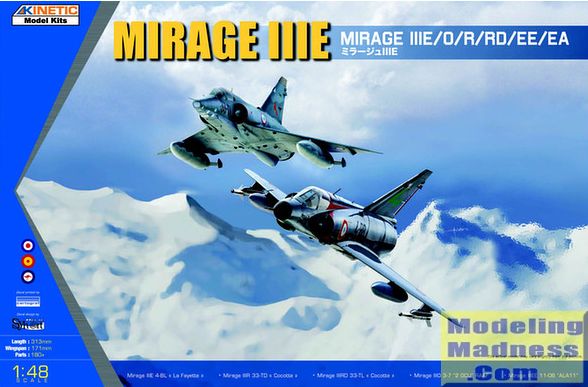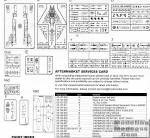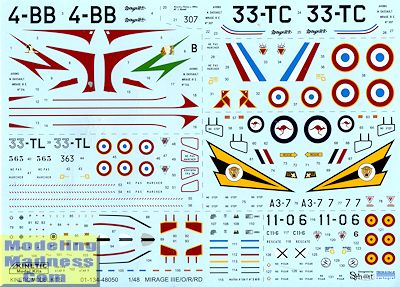
| KIT #: | K48050 |
| PRICE: | 6560 yen at www.hlj.com (about $54.00). 8200 yen SRP. |
| DECALS: | Five options |
| REVIEWER: | Scott Van Aken |
| NOTES: |

| HISTORY |
While the Mirage IIIC was being put into production, Dassault was also considering a multirole/strike variant of the aircraft, which eventually materialized as the Mirage IIIE. The first of three prototypes flew on 1 April 1961.
The Mirage IIIE differed from the IIIC interceptor most obviously in having a 30 cm (11.8 in) forward fuselage extension to increase the size of the avionics bay behind the cockpit. The stretch also helped increase fuel capacity, as the Mirage IIIC had marginal range and improvements were needed. The stretch was small and hard to notice, but the clue is that the bottom edge of the canopy on a Mirage IIIE ends directly above the top lip of the air intake, while on the IIIC it ends visibly back of the lip.
Many Mirage IIIE variants were also fitted with a Marconi continuous-wave Doppler navigation radar radome on the bottom of the fuselage, under the cockpit. However, while no IIICs had this feature, it was not universal on all variants of the IIIE. A similar inconsistent variation in Mirage fighter versions was the presence or absence of an HF antenna that was fitted as a forward extension to the vertical tailplane. On some Mirages, the leading edge of the tailplane was a straight line, while on those with the HF antenna the leading edge had a sloping extension forward. The extension appears to have been generally standard on production Mirage IIIAs and Mirage IIICs, but only appeared in some of the export versions of the Mirage IIIE.
The IIIE featured Thomson-CSF Cyrano II dual mode air / ground radar; a radar warning receiver (RWR) system with the antennas mounted in the vertical tailplane; and an Atar 09C engine, with a petal-style variable exhaust.
The first production Mirage IIIE was delivered to the AdA in January 1964, and a total of 192 were eventually delivered to that service.
Total production of the Mirage IIIE, including exports, was substantially larger than that of the Mirage IIIC, including exports, totaling 523 aircraft. In the mid-1960s one Mirage IIIE was fitted with the improved SNECMA Atar 09K-6 turbojet for trials, and given the confusing designation of Mirage IIIC2.
| THE KIT |
 Considering how popular the Mirage IIIE and all its subvariants are in the modeling world, it is quite surprising that we had yet to have a modern tool version of this in 1/48. Sure, the ESCI kit, which could also be found in Revell and Italeri boxes was a nice kit for its time, but it was quite lacking in the sort of detail modern modelers expect. Of course Kinetic has done the quite similar Kfir kit so I guess it was just a matter of time before they got around to the IIIE.
Considering how popular the Mirage IIIE and all its subvariants are in the modeling world, it is quite surprising that we had yet to have a modern tool version of this in 1/48. Sure, the ESCI kit, which could also be found in Revell and Italeri boxes was a nice kit for its time, but it was quite lacking in the sort of detail modern modelers expect. Of course Kinetic has done the quite similar Kfir kit so I guess it was just a matter of time before they got around to the IIIE.
Now, we have a modern tool Mirage IIIE. This particular kit will make either the standard fighter-bomber or the reconnaissance version, specifically the Mirage IIIE/O/R/RD/EE/EA variations. I should mention that it does not include markings for the EA variant. All of these plane are without the extended fin that housed an HF radio antenna and is common with many other foreign buyers such as Brazil. One would think that this variant would be produced later on as the small extended fin section is included on the sprues as are a set of canards.
If you have ever seen a Kinetic kit, then you are aware of how the molding is done. It is nicely engraved with engraved rivet detail and is a bit 'soft' when compared to companies like Hasegawa or Tamiya. None of that detracts from the finished product. The kit does not offer any photo etch though it would be nice to at least provide a seat harness.
So let us take a journey through the instruction sheet and see what is provided. First off is the cockpit. There are two seat types offered, Martin-Baker Mk.4 seats for most of the options and a Mk.10 for the Mirage IIIRD. On the Mk.4 you have two styles of face curtain handles so check your references. The seats are nicely done, but really would benefit from a resin replacement. There is a single tub with control stick, foot pedals and different instrument panels for the fighter and recce versions. There are also quite a few black boxes to put on the aft bulkhead. The detail on consoles and instrument panel are raised. There is no instrument decal.
 Instructions are quite well done with multiple color options and while all the paint colors provided during the build are in Humbrol numbers, the chart provided gives alternate paint brands. Markings are for five aircraft, three of them French. Both of the recce birds are with ER 3/33 at different times of their life. The other French plane is an early delivery one in unpainted metal from EC 1/4 'Lafayette' in 1967. There is also a camouflaged IIIEE of the Spanish Air Force in 1986 and an Australian IIIEO of 2 OCU in 1987. This one is in the greys scheme that some planes wore in their final years. The decal sheet is very nicely done by Cartograf and provides all the stencils needed for both the aircraft and weapons. There is a full stencil guide in the instructions. I should point out one complaint and that is on the camouflaged planes the ink is so dark that in some cases it is impossible to see the markings on the airframe where there is dark green.
Instructions are quite well done with multiple color options and while all the paint colors provided during the build are in Humbrol numbers, the chart provided gives alternate paint brands. Markings are for five aircraft, three of them French. Both of the recce birds are with ER 3/33 at different times of their life. The other French plane is an early delivery one in unpainted metal from EC 1/4 'Lafayette' in 1967. There is also a camouflaged IIIEE of the Spanish Air Force in 1986 and an Australian IIIEO of 2 OCU in 1987. This one is in the greys scheme that some planes wore in their final years. The decal sheet is very nicely done by Cartograf and provides all the stencils needed for both the aircraft and weapons. There is a full stencil guide in the instructions. I should point out one complaint and that is on the camouflaged planes the ink is so dark that in some cases it is impossible to see the markings on the airframe where there is dark green. | CONCLUSIONS |
I'm very pleased that this one has been released and apparently modelers agree as HLJ sold out of their first batch of these within a day or two. I can foresee several other III variants being done as well as a nice batch of Mirage Vs and perhaps some two seaters as well.
| REFERENCES |
http://en.wikipedia.org/wiki/Mirage_III
March 2015Thanks to www.hlj.com for the preview kit. You can find this kit at this link.
If you would like your product reviewed fairly and fairly quickly, please contactthe editor or see other details in the